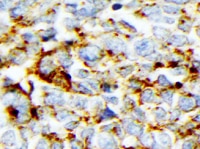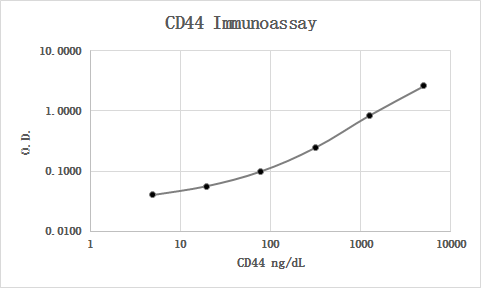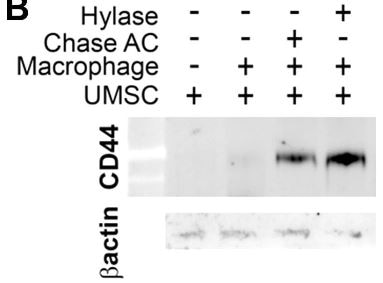Human CD44s Pan Specific Antibody Summary
Applications
Please Note: Optimal dilutions should be determined by each laboratory for each application. General Protocols are available in the Technical Information section on our website.
Scientific Data
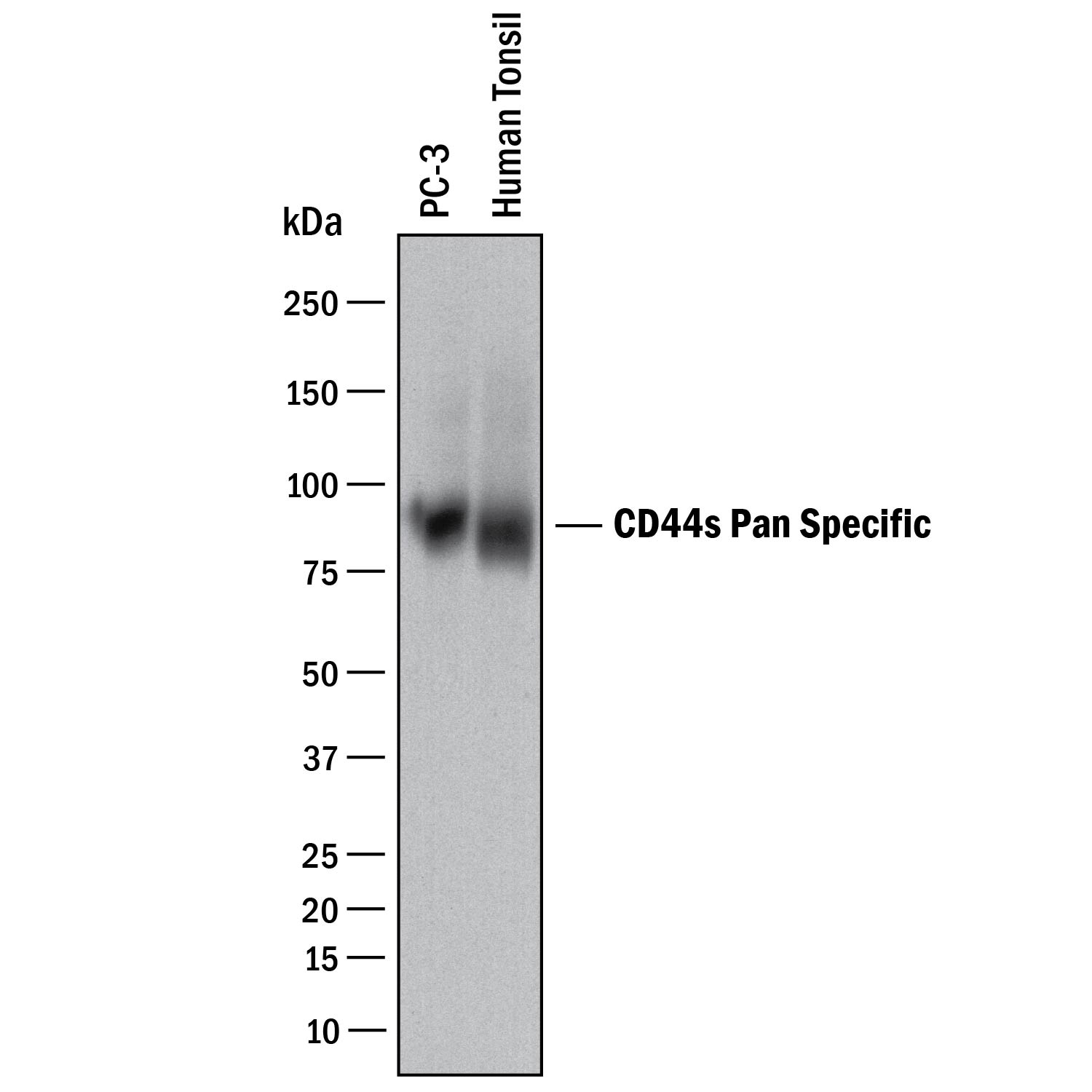 View Larger
View Larger
Detection of Human CD44 by Western Blot. Western blot shows lysates of PC-3 human prostate cancer cell line and human tonsil tissue. PVDF membrane was probed with 2 µg/mL of Mouse Anti-Human CD44 s Pan Specific Monoclonal Antibody (Catalog # BBA10) followed by HRP-conjugated Anti-Mouse IgG Secondary Antibody (Catalog # HAF018). A specific band was detected for CD44 at approximately 90 kDa (as indicated). This experiment was conducted under reducing conditions and using Immunoblot Buffer Group 1.
 View Larger
View Larger
CD44 in Human Lymphoma. CD44 was detected in immersion fixed paraffin-embedded sections of human lymphoma using Mouse Anti-Human CD44 s Pan Specific Monoclonal Antibody (Catalog # BBA10) at 15 µg/mL overnight at 4 °C. Tissue was stained using the Anti-Mouse HRP-DAB Cell & Tissue Staining Kit (brown; Catalog # CTS002) and counterstained with hematoxylin (blue). Specific staining was localized to plasma membrane. View our protocol for Chromogenic IHC Staining of Paraffin-embedded Tissue Sections.
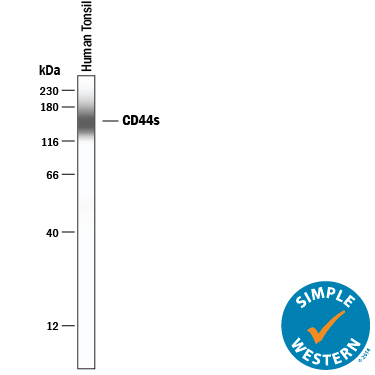 View Larger
View Larger
Detection of Human CD44 by Simple WesternTM. Simple Western lane view shows lysates of human tonsil tissue, loaded at 0.2 mg/mL. A specific band was detected for CD44 at approximately 156 kDa (as indicated) using 20 µg/mL of Mouse Anti-Human CD44 s Pan Specific Monoclonal Antibody (Catalog # BBA10). This experiment was conducted under reducing conditions and using the 12-230 kDa separation system.
Reconstitution Calculator
Preparation and Storage
- 12 months from date of receipt, -20 to -70 °C as supplied.
- 1 month, 2 to 8 °C under sterile conditions after reconstitution.
- 6 months, -20 to -70 °C under sterile conditions after reconstitution.
Background: CD44
CD44 is a ubiquitously expressed protein that is the major receptor for hyaluronan and exerts control over cell growth and migration (1-3). Human CD44 has a 20 amino acid (aa) signal sequence, an extracellular domain (ECD) with a 100 aa hyaluronan-binding disulfide-stabilized link region and a 325-530 aa stem region, a 21 aa transmembrane domain, and a 72 aa cytoplasmic domain. Within the stem, ten variably spliced exons (v1-10, exons 6-15) produce multiple protein isoforms (1‑3). The standard or hematopoietic form, CD44s, does not include the variable segments (1‑3). Cancer aggressiveness and T cell activation have been correlated with expression of specific isoforms (1, 3). With variable N- and O-glycosylation and splicing within the stalk, CD44 can range from 80-200 kDa (1). Within the N‑terminal invariant portion of the ECD (aa 21-220), human CD44 shares 76%, 76%, 86%, 83%, and 79% identity with corresponding mouse, rat, equine, canine, and bovine CD44, respectively. The many reported functions of CD44 fall within three categories (1). First, CD44 binds hyaluronan and other ligands within the extracellular matrix and can function as a “platform” for growth factors and metalloproteinases. Second, CD44 can function as a co-receptor that modifies activity of receptors including MET and the ERBB family of tyrosine kinases. Third, the CD44 intracellular domain links the plasma membrane to the actin cytoskeleton via the ERM proteins, ezrin, radixin and moesin. CD44 can be synthesized in a soluble form (4) or may be cleaved at multiple sites by either membrane-type matrix metalloproteinases, or ADAM proteases to produce soluble ectodomains (5, 6). The cellular portion may then undergo gamma secretase-dependent intramembrane cleavage to form an A beta -like transmembrane portion and a cytoplasmic signaling portion that affects gene expression (7, 8). These cleavage events are thought to promote metastasis by enhancing tumor cell motility and growth (1, 5).
- Ponta, H. et al. (2003) Nat. Rev. Mol. Cell Biol. 4:33.
- Screaton, G.R. et al. (1992) Proc. Natl. Acad. Sci. USA 89:12160.
- Lynch, K.W. (2004) Nat. Rev. Immunol. 4:931.
- Yu, Q. and B.P. Toole (1996) J. Biol. Chem. 271:20603.
- Nagano, O. and H. Saya (2004) Cancer Sci. 95:930.
- Nakamura, H. et al. (2004) Cancer Res. 64:876.
- Murakami, D. et al. (2003) Oncogene 22:1511.
- Lammich, S. et al. (2002) J. Biol. Chem. 277:44754.
Product Datasheets
Citations for Human CD44s Pan Specific Antibody
R&D Systems personnel manually curate a database that contains references using R&D Systems products. The data collected includes not only links to publications in PubMed, but also provides information about sample types, species, and experimental conditions.
23
Citations: Showing 1 - 10
Filter your results:
Filter by:
-
Negative regulation of CD44st by miR-138-5p affects the invasive ability of breast cancer cells and patient prognosis after breast cancer surgery
Authors: FX Jian, PX Bao, WF Li, YH Cui, HG Hong
BMC Cancer, 2023-03-24;23(1):269.
Species: Human
Sample Types: Cell Lysates
Applications: Western Blot -
RUNX2 interacts with BRG1 to target CD44 for promoting invasion and migration of colorectal cancer cells
Authors: X Yan, D Han, Z Chen, C Han, W Dong, L Han, L Zou, J Zhang, Y Liu, J Chai
Cancer Cell Int, 2020-10-15;20(0):505.
Species: Human
Sample Types: Whole Tissue
Applications: IHC -
The deubiquitylase OTUB1 mediates ferroptosis via stabilization of SLC7A11
Authors: T Liu, L Jiang, O Tavana, W Gu
Cancer Res., 2019-02-01;0(0):.
Species: Human
Sample Types: Whole Cells
Applications: Western Blot -
Fluoxetine induces direct inhibitory effects on mesenchymal stem cell?derived osteoprogenitor cells independent of serotonin concentration
Authors: SM Koura, M Salama, M El-Hussiny, MEA Khalil, A Lotfy, SA Hassan, SA Gad Elhak, MA Sobh
Mol Med Rep, 2019-02-01;0(0):.
Species: Rat
Sample Types: Whole Cells
Applications: Flow Cytometry -
Secondary lymphoid organ fibroblastic reticular cells mediate trans-infection of HIV-1 via CD44-hyaluronan interactions
Authors: T Murakami, J Kim, Y Li, GE Green, A Shikanov, A Ono
Nat Commun, 2018-06-22;9(1):2436.
Species: Human
Sample Types: Cell Lysates
Applications: Western Blot -
Optimizing human Treg immunotherapy by Treg subset selection and E-selectin ligand expression
Authors: C Donnelly, B Dykstra, N Mondal, J Huang, BJ Kaskow, R Griffin, R Sackstein, C Baecher-Al
Sci Rep, 2018-01-11;8(1):420.
Species: Human
Sample Types: Cell Lysates
Applications: Immunoprecipitation -
Akt signaling is sustained by a CD44 splice isoform-mediated positive feedback loop
Authors: S Liu, C Cheng
Cancer Res., 2017-05-22;0(0):.
Species: Human
Sample Types: Cell Lysates, Whole Cells
Applications: Neutralization, Western Blot -
Cell-Specific Variation in E-Selectin Ligand Expression among Human Peripheral Blood Mononuclear Cells: Implications for Immunosurveillance and Pathobiology
Authors: M Silva, RK Fung, CB Donnelly, PA Videira, R Sackstein
J. Immunol, 2017-03-22;0(0):.
Species: Human
Sample Types: Cell Lysates, Whole Cells
Applications: Flow Cytometry, Immunoprecipitation, Western Blot -
Glycoengineering of E-selectin ligands by intracellular versus extracellular fucosylation differentially affects osteotropism of human mesenchymal stem cells
Authors: Brad Dykstra
Stem Cells, 2016-07-17;0(0):.
Species: Human
Sample Types: Cell Lysates
Applications: Immunoprecipitation -
PiggyBac transposon-mediated gene delivery efficiently generates stable transfectants derived from cultured primary human deciduous tooth dental pulp cells (HDDPCs) and HDDPC-derived iPS cells.
Authors: Inada E, Saitoh I, Watanabe S, Aoki R, Miura H, Ohtsuka M, Murakami T, Sawami T, Yamasaki Y, Sato M
Int J Oral Sci, 2015-09-14;7(3):144-54.
Species: Human
Sample Types: Whole Cells
Applications: ICC -
Quantitative Characterization of E-selectin Interaction with Native CD44 and P-selectin Glycoprotein Ligand-1 (PSGL-1) Using a Real Time Immunoprecipitation-based Binding Assay.
Authors: AbuSamra D, Al-Kilani A, Hamdan S, Sakashita K, Gadhoum S, Merzaban J
J Biol Chem, 2015-06-29;290(35):21213-30.
Species: Human
Sample Types: Cell Lysates, Protein
Applications: Surface Plasmon Resonance, Western Blot -
C6-ceramide nanoliposome suppresses tumor metastasis by eliciting PI3K and PKCzeta tumor-suppressive activities and regulating integrin affinity modulation.
Authors: Zhang P, Fu C, Hu Y, Dong C, Song Y, Song E
Sci Rep, 2015-03-20;5(0):9275.
Species: Human
Sample Types: Whole Cells
Applications: Flow Cytometry -
MIF inhibits monocytic movement through a non-canonical receptor and disruption of temporal Rho GTPase activities in U-937 cells.
Authors: DiCosmo-Ponticello C, Hoover D, Coffman F, Cohen S, Cohen M
Cytokine, 2014-06-06;69(1):47-55.
Species: Human
Sample Types: Cell Lysates
Applications: Western Blot -
Coexpression of EpCAM, CD44 variant isoforms and claudin-7 in anaplastic thyroid carcinoma.
Authors: Okada, Toshihir, Nakamura, Teruo, Watanabe, Takayuki, Onoda, Naoyoshi, Ashida, Atsuko, Okuyama, Ryuhei, Ito, Ken-ichi
PLoS ONE, 2014-04-11;9(4):e94487.
Species: Human
Sample Types: Whole Tissue
Applications: IHC -
CD26 expression on T-anaplastic large cell lymphoma (ALCL) line Karpas 299 is associated with increased expression of versican and MT1-MMP and enhanced adhesion.
Authors: Havre, Pamela A, Dang, Long H, Ohnuma, Kei, Iwata, Satoshi, Morimoto, Chikao, Dang, Nam H
BMC Cancer, 2013-11-01;13(0):517.
Species: Human
Sample Types: Cell Lysates
Applications: Western Blot -
KCa3.1 and TRPM7 channels at the uropod regulate migration of activated human T cells.
Authors: Kuras Z, Yun Y, Chimote A, Neumeier L, Conforti L
PLoS ONE, 2012-08-27;7(8):e43859.
Species: Human
Sample Types: Whole Cells
Applications: ICC -
Increased NOS2 predicts poor survival in estrogen receptor-negative breast cancer patients.
Authors: Glynn SA, Boersma BJ, Dorsey TH, Yi M, Yfantis HG, Ridnour LA, Martin DN, Switzer CH, Hudson RS, Wink DA, Lee DH, Stephens RM, Ambs S
J. Clin. Invest., 2010-10-18;120(11):3843-54.
Species: Human
Sample Types: Cell Lysates
Applications: Western Blot -
Synovial sarcoma is a stem cell malignancy.
Authors: Naka N, Takenaka S, Araki N
Stem Cells, 2010-07-01;28(7):1119-31.
Species: Human
Sample Types: Whole Cells
Applications: ICC -
Anticancer chemotherapy inhibits MHC class I-related chain a ectodomain shedding by downregulating ADAM10 expression in hepatocellular carcinoma.
Authors: Kohga K, Takehara T, Tatsumi T, Miyagi T, Ishida H, Ohkawa K, Kanto T, Hiramatsu N, Hayashi N
Cancer Res., 2009-10-13;69(20):8050-7.
Species: Human
Sample Types: Whole Tissue
Applications: IHC -
The E-selectin ligand basigin/CD147 is responsible for neutrophil recruitment in renal ischemia/reperfusion.
Authors: Kato N, Yuzawa Y, Kosugi T
J. Am. Soc. Nephrol., 2009-05-14;20(7):1565-76.
Species: Mouse
Sample Types: Tissue Homogenates
Applications: Western Blot -
Inflammatory cytokines stimulate the adhesion of colon carcinoma cells to mesothelial monolayers.
Authors: van Grevenstein WM, Hofland LJ, van Rossen ME, van Koetsveld PM, Jeekel J, van Eijck CH
Dig. Dis. Sci., 2007-03-30;52(10):2775-83.
Species: Human
Sample Types: Whole Cells
Applications: ICC -
Cortactin underpins CD44-promoted invasion and adhesion of breast cancer cells to bone marrow endothelial cells.
Authors: Hill A, McFarlane S, Mulligan K, Gillespie H, Draffin JE, Trimble A, Ouhtit A, Johnston PG, Harkin DP, McCormick D, Waugh DJ
Oncogene, 2006-05-01;25(45):6079-91.
Species: Human
Sample Types: Cell Lysates, Whole Cells
Applications: ICC, Western Blot -
CD44 potentiates the adherence of metastatic prostate and breast cancer cells to bone marrow endothelial cells.
Authors: Draffin JE, McFarlane S, Hill A, Johnston PG, Waugh DJ
Cancer Res., 2004-08-15;64(16):5702-11.
Species: Human
Sample Types: Whole Cells
Applications: Flow Cytometry, ICC
FAQs
No product specific FAQs exist for this product, however you may
View all Antibody FAQsReviews for Human CD44s Pan Specific Antibody
Average Rating: 4.7 (Based on 9 Reviews)
Have you used Human CD44s Pan Specific Antibody?
Submit a review and receive an Amazon gift card.
$25/€18/£15/$25CAN/¥75 Yuan/¥2500 Yen for a review with an image
$10/€7/£6/$10 CAD/¥70 Yuan/¥1110 Yen for a review without an image
Filter by:
MAB7045 was used as the capture antibody along with BBA10 as the detection antibody. Recombinant human CD44 Fc Chimera (3660-CD) was used as the calibrator material. Human serum and plasma samples were diluted 1:5 and all were quantifiable. Parallelism looked good.
Chondroitiase treated increase CD44 when co-culture with macrophage
